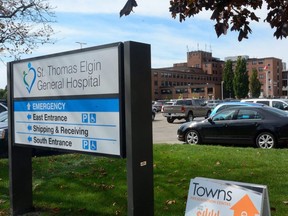The region’s largest hospital is making progress on moving emergency room patients to inpatient beds faster, but is warning of longer wait times in its two ERs as flu season gets into full swing.

The region’s largest hospital is making progress on moving emergency room patients to inpatient beds faster, but is warning of longer wait times in its two ERs as flu season gets into full swing. Here’s what you need to know.
Advertisement 2
Article content
Article content
Article content
ER WAIT TIMES IN LONDON
London Health Sciences Center on Thursday put out a public bulletin asking the community for patience as it experienced “longer than normal wait times” in its emergency rooms. The hospital reported average wait times for non-urgent patients of up to nine hours at its two ERs, which receive more than 170,000 visits a year, on Thursday.
As of Friday afternoon, the ER wait time at University Hospital was 5.5 hours, while Victoria Hospital had an estimated wait time of eight hours.
“Our partners across the region are seeing fluctuations in surge volumes and our clinical teams are continuing to expedite all possible appropriate discharges while also working to stabilize capacity,” Deborah Wiseman, vice-president of medicine, emergency services and critical care, said in a statement Friday.
Advertisement 3
Article content
Surgeries have not been canceled as a result of the recent surge in patients, Wiseman said, but the hospital is monitoring the situation to “ensure adequate capacity is preserved for those who require the highest level of acute care.”
Compared to 2023, LHSC has made progress on speeding up the time it takes ER patients who need to be admitted to get a bed.
As of October, patients at University Hospital were spending an average of eight hours in ER beds awaiting a move to an inpatient unit, down from 14 hours at the same point last year.
At Victoria Hospital last month, the wait from ER to inpatient unit was an average of six hours, down from 11 hours in the same month in 2023.
PROVINCEWIDE
As of September, patients in Ontario hospitals waited, on average, 2.1 hours in the emergency department before seeing a doctor, according to the latest data from Ontario Health, a provincial agency that co-ordinates and oversees health care delivery.
Advertisement 4
Article content
Patients admitted to hospital spent an average of 20.7 hours in the ER before moving to an inpatient bed, with just 26 per cent of patients moving to an inpatient unit within the eight-hour target time.
WHY DOES LONG WAITS HAPPEN?
There are a variety of factors that can contribute to ER wait times. Respiratory virus season increases the number of patients coming to emergency rooms provincewide, leading to longer waits. Since patients are triaged based on their condition, a flood of seriously sick or injured patients can mean less acute patients wait longer for care.
Bottlenecks in patient flow within a hospital also can contribute to long wait times. Patients in the ER who are being admitted need a spot on an inpatient floor before they can free up the emergency room space they’re occupying. Tie-ups in discharging other patients from inpatient beds can keep ER beds occupied for longer.
Advertisement 5
Article content
Staff illness and planned time-off also can put added pressure on hospitals during the fall and winter months.
WHAT’S NEXT?
Seasonal respiratory season brings more patients to LHSC’s emergency rooms than other times of year, meaning potentially longer ER visits and increased wait times for inpatient beds, LHSC said.
“We are committed to our patients’ care and experience at LHSC and will continue to do everything we can to minimize the time our admitted patients spend waiting for an inpatient bed,” LHSC said in a statement.
ER visits and hospital admissions for respiratory illnesses are beginning to increase in London and Middlesex County, data from the Middlesex-London Health Unit shows.
Last flu season, ER visits and admissions in London-area hospitals peaked in late December through early January.
Advertisement 6
Article content
IN THE REGION
At the St. Thomas Elgin General Hospital, patients spent an average of 1.3 hours in the ER waiting to be seen by a doctor in September, according to the latest data from Ontario Health. Patients who were admitted spent an average of 4.5 hours in the emergency room at STEGH before they were moved to an inpatient unit.
STEGH has worked to keep its ER wait times in check through a “co-ordinated, hospital-wide approach to patient flow and access,” the hospital said in a statement.

“While we are still considered a community hospital, our volumes continue to escalate and we are on track to see over 59,000 visits this year,” the hospital said.
By noon on Monday, a high-demand day for STEGH, the hospital had triaged 95 people.
Members of the hospital’s leadership team meet twice daily to spot pressure points at STEGH and make plans to move patients as needed. STEGH also co-ordinates with families and home care to get patients discharge efficiently.
In September, the average wait time to see a doctor at the Woodstock Hospital ER was 1.7 hours, with patients spending an average of 5.2 hours in the emergency room before being admitted.
Recommended from Editorial
Article content


